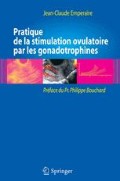Résumé
La stimulation ovarienne monofolliculaire ou paucifolliculaire vise à restaurer ou corriger le processus ovulatoire chez une patiente lorsqu’il ne s’effectue pas, ou de manière inadéquate, ou à recruter ou sauver de l’atrésie un à quelques follicules supplémentaires; à l’inverse, la stimulation multifolliculaire organise le dérèglement de la physiologie ovarienne de manière à provoquer le développement et la maturation de follicules plus nombreux.
Preview
Unable to display preview. Download preview PDF.
Références
Ulloa-Aguirre A, Timossi C (1998) Structure-function relationship of follicle-stimulating hormone and its receptor. Hum Reprod Update 4: 260–83
Stanton PG, Burgon PG, Hearn MTW, Robertson DM (1996) Structural and functional characterisation of FSH and LH isoforms. Moll Cell Endocrinol 125: 133–41
Ulloa-Aguirre A, Timossi C, Mendez JP (2001) Is there any physiological role for gonadotrophin oligosaccharide heterogeneity in humans?-I-Gonadotrophins are synthetized and released in multiple molecular forms. A matter of fact. Hum Reprod 16(4): 599–604
Bousfield GR, Butnev VY, Walton W et al. (2007) All-or-none N-glycosylation in primate follicle stimulating hormone β-subunits. Mo Cell Endocrinol 262: 40–8
D’Antonio M, Borrelli F, Datola A et al. (1999) Biological characterization of recombinant human follicle stimulating hormone isoforms. Hum Reprod 14: 1160–7
Timossi CM, Barrios-de-Tomasi J, Gonzalez-Suarez R et al. (2000) Differential effects of the charge variants of human follicle stimulating hormone. J Endocrinol 165: 193–205
Wide L, Eriksson K, Sluss PM, Hall JE (2009) Serum half life of pituitary gonadotropins is decreased by sulfonation and increased by sialylation in women. J Clin Endocrinol Metab 94: 958–64
Anobile CJ, Talbot JA, McCann SJ et al. (1998) Glycoform composition of serum gonadotrophins through the normal menstrual cycle and in the post-menopause state. Mol Hum Reprod 4: 631–9
Phillips DJ, Albertson-Xikland K, Eriksson K et al. (1997) Changes in the isoform of luteinizing hormone and follicle stimulating hormone during puberty in normal children. J Clin Endocrinol Metab 82: 3103–6
Ryan RJ, Charlesworth MC, McCormick DJ, ilius RP et al. (1982) The glycoprotein hormones: recent studies of structure-function relationship. FASEB J 2: 2661–9
Nayudu P, Vitt UA, Barrios de Tomasi J et al. (2002) Intact follicle culture: what it can tell us about the roles of glycoforms during follicle development. Reprod Biomed Online 5: 240–53
Emperaire JC (2011) Propriétés et intérêt clinique des isoformes de la FSH. MT Med Reprod Gynecol Endocrinol 13: 49–60
Hughes JN (2011) Récepteur de la FSH et stimulation ovarienne. In: Franchin R (ed) La stimulation ovarienne-Concepts et réalités. MED’COM, Paris, p. 41
Perez Mayorga M, Gromoll J, Behre HM et al. (2000) Ovarian response to follicle-stimulating hormone (FSH) stimulation depends on the FSH receptor genotype. J Clin Endocrinol Metab 85: 3365–9
Daelemans C, Smits G, de Maertelaer V et al (2004) Prediction of severity of symptoms in iatrogenic ovarian hyperstimulation syndrome by follicle-stimulating hormone receptor Ser680Asn polymorphism. J Clin Endocrinol Metab 89: 6310–5
Stanton PG, Pozvek G, Burgon PG et al. (1993) Isolation and characterization of human LH isoforms. J Endocrinol 138: 529–43
Burgon PG, Stanton PG, Robertson DM (1996) In vivo bioactivities and clearance patterns of highly purified human luteinizing hormone isoforms. Endocrinology 137: 4827–36
Ropelato MG, Garcia-Rudaz MC et al (1999) A preponderance of basic luteinizing (LH) isoforms accompanies inappropriate hypersecretion of both basal andpulsatile LH in adolescents with polycystic ovarian syndrome. J Clin Endocrinol Metab 84:4629–36
Wide L, Eriksson K, Sluss PM, all JE (2010) The common genetic variant of luteinizing hormone has a longer half life than the wild type in heterozygotous women. J Clin Endocrinol Metab 95: 383–9
Cole LA (2009) New discoveries on the biology and detection of human chorionic gonadotropin. Reprod Biol Endocrinol 7: 1–47
Author information
Authors and Affiliations
Rights and permissions
Copyright information
© 2013 Springer-Verlag France
About this chapter
Cite this chapter
Emperaire, JC. (2013). Rappel physiologique. In: Pratique de la stimulation ovulatoire par les gonadotrophines. Springer, Paris. https://doi.org/10.1007/978-2-8178-0398-2_2
Download citation
DOI: https://doi.org/10.1007/978-2-8178-0398-2_2
Publisher Name: Springer, Paris
Print ISBN: 978-2-8178-0397-5
Online ISBN: 978-2-8178-0398-2
eBook Packages: MedicineMedicine (R0)

